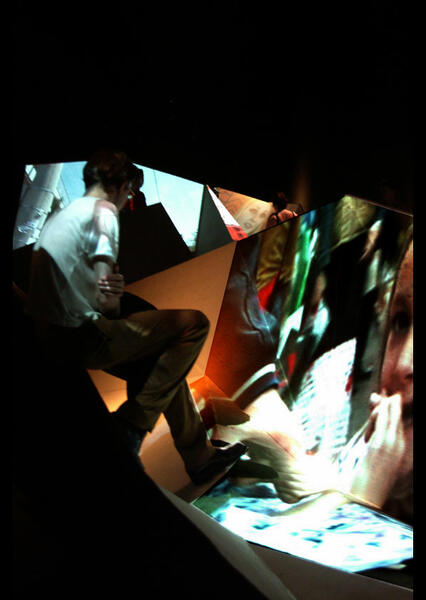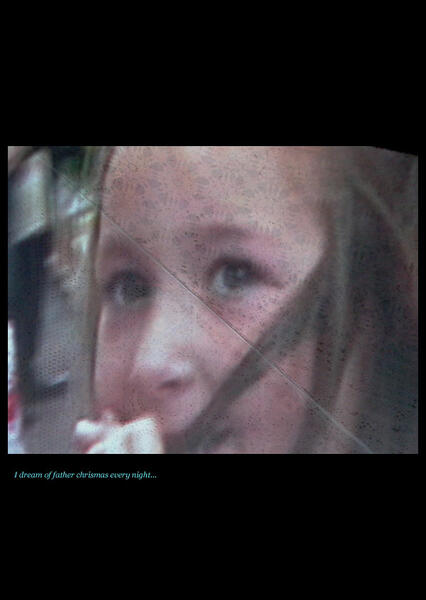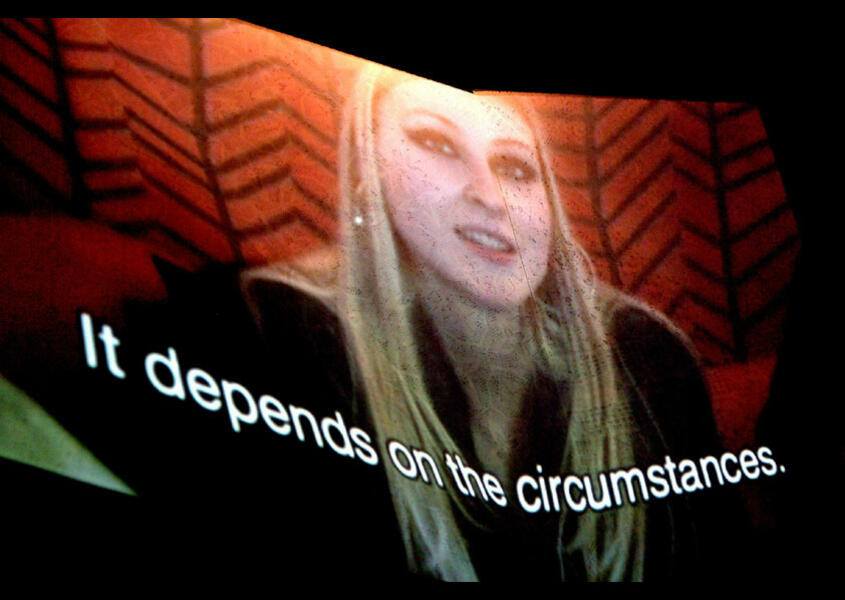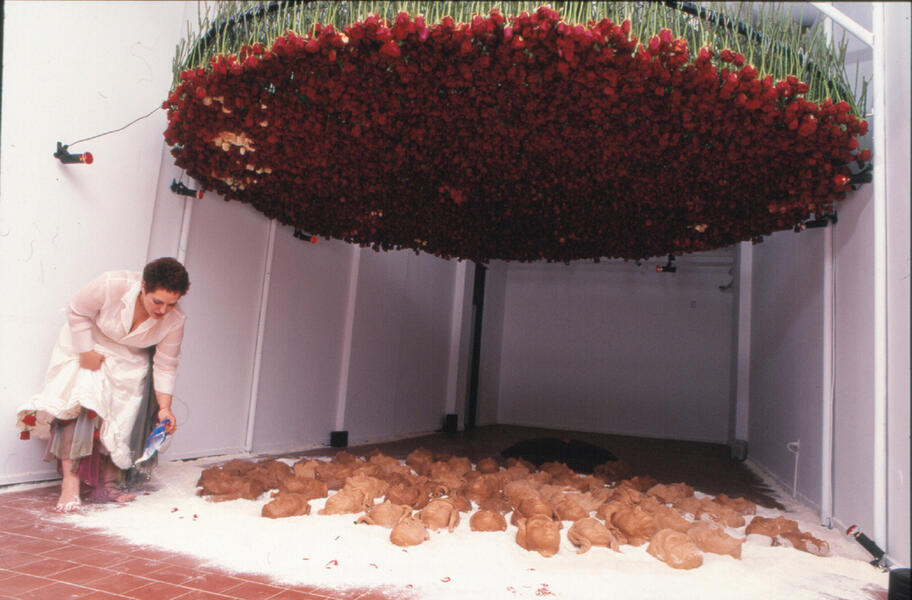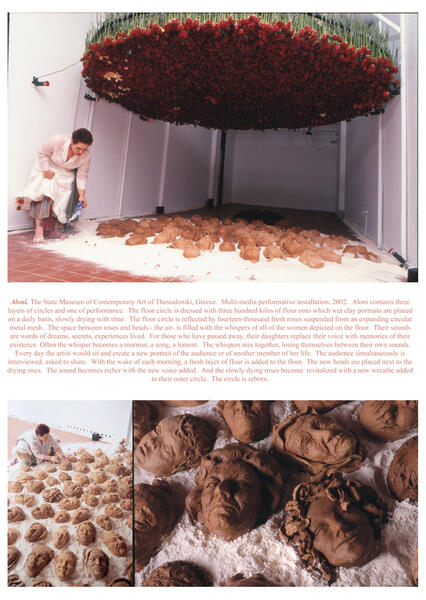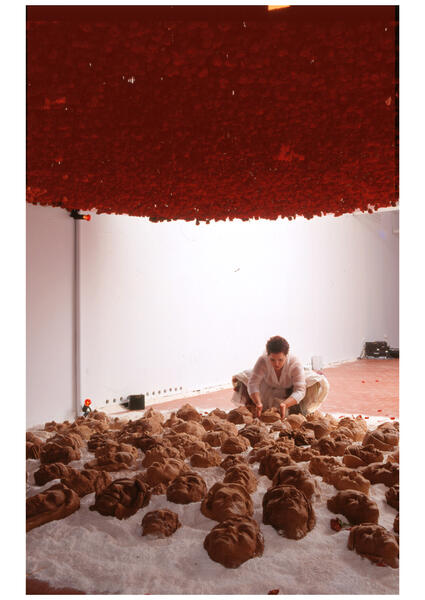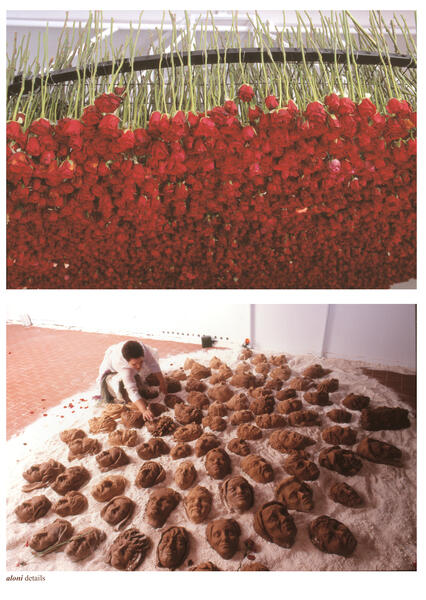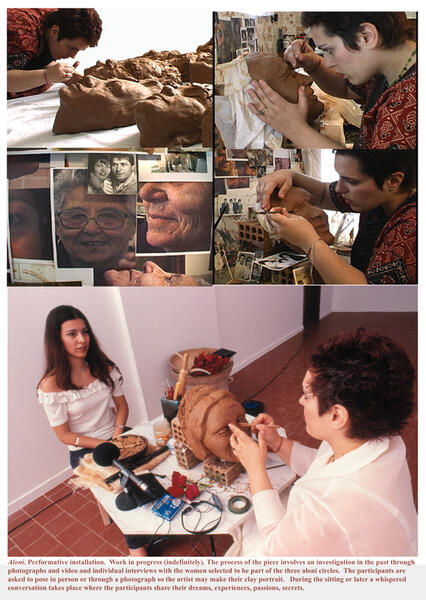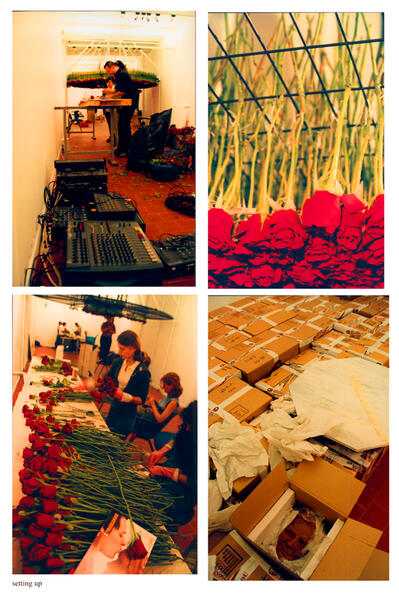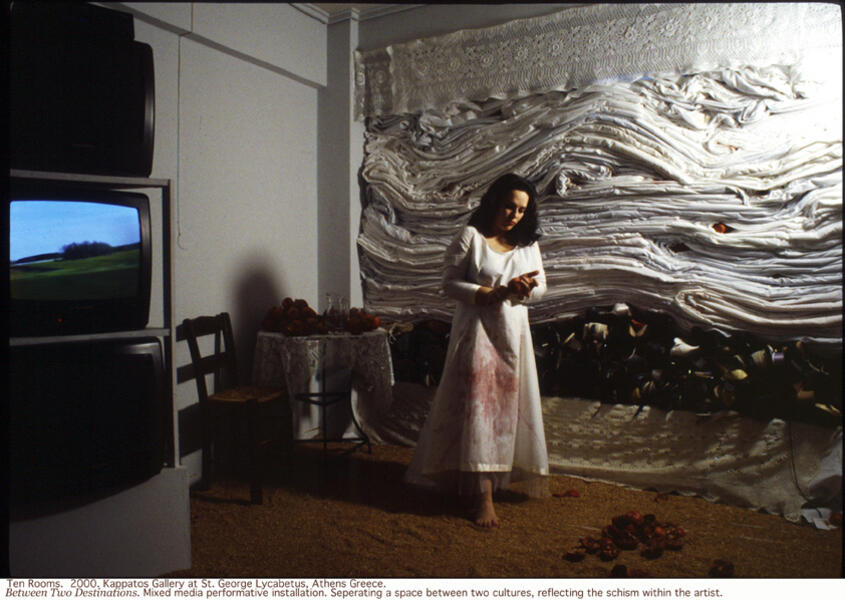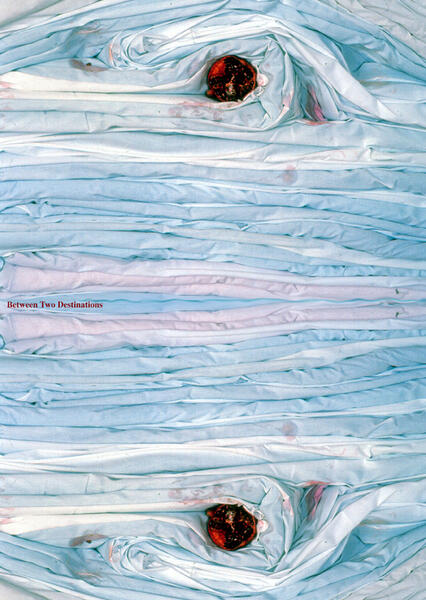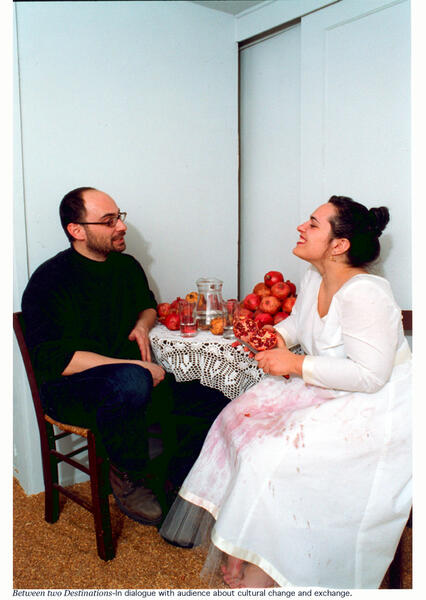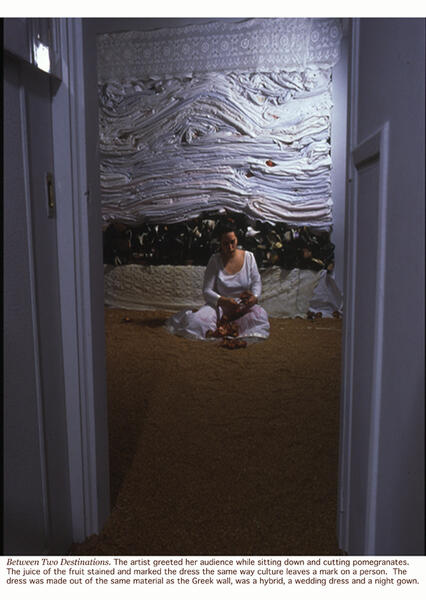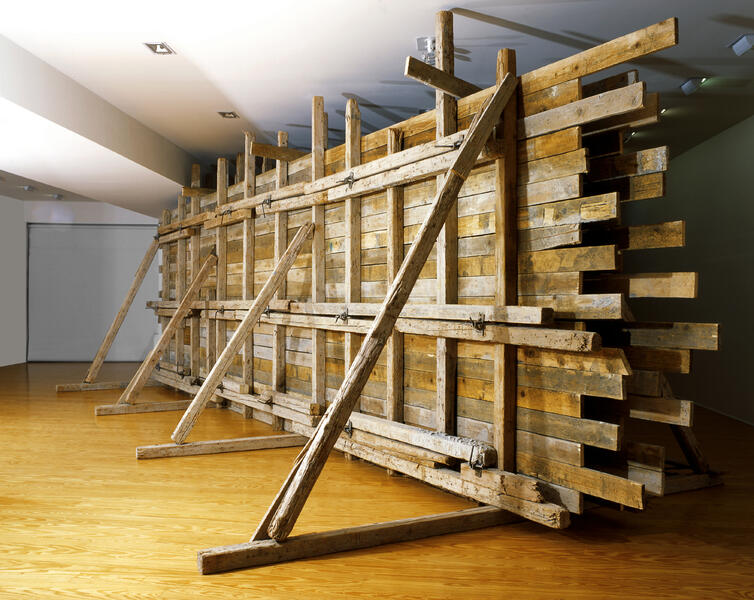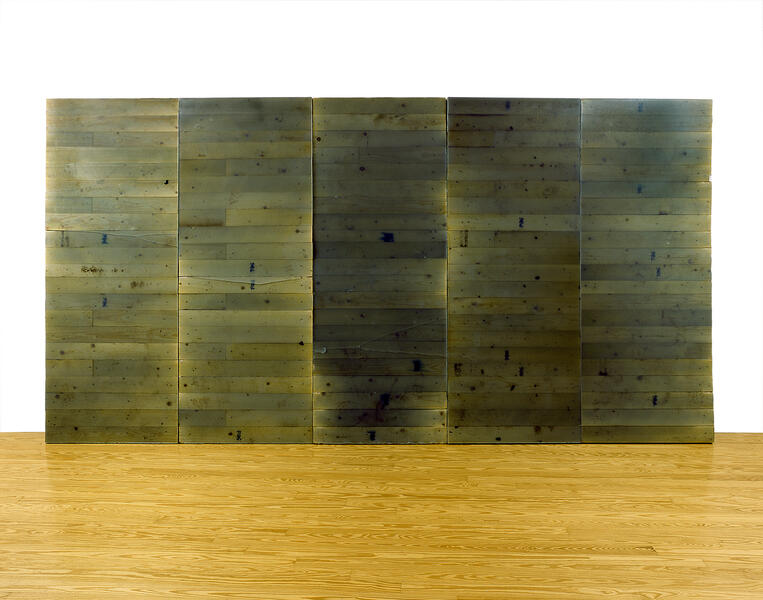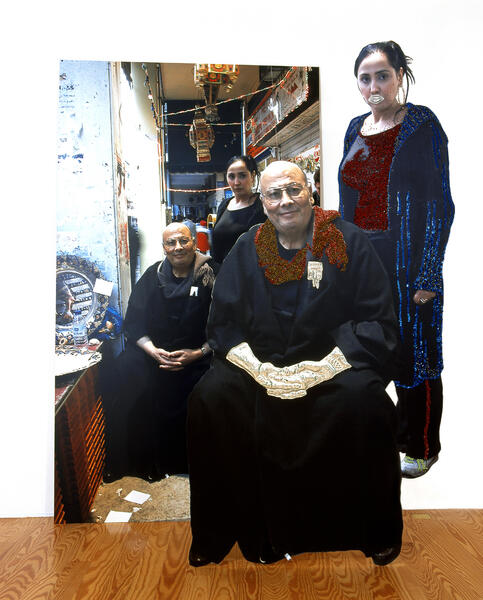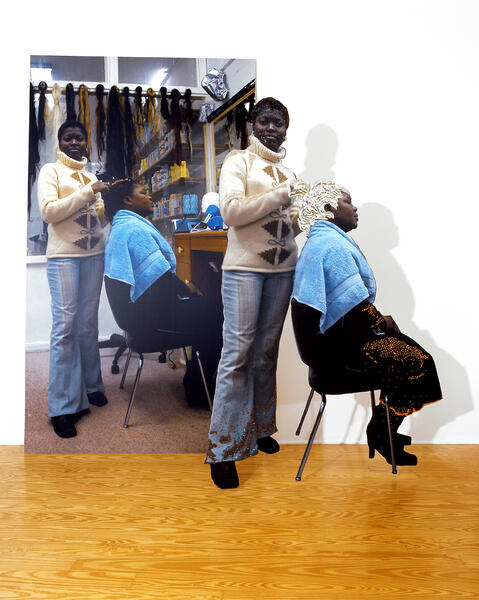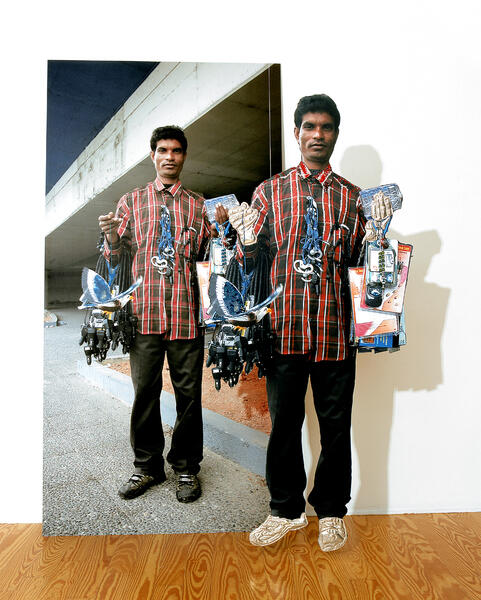About Athanasia
Athanasia Kyriakakos is an internationally known visual artist. Her performances, installations, sculptures, and photographs work to create instant community and to recontextualize daily experiences, often drawing from her Greek heritage as a starting point for her ideas. She is represented by a.antonopoulou.art in Athens, Greece. (www.aaart.gr)
Solo exhibitions include "Babylon"; at her gallery, and "Aloni", a retrospective at the National Museum of Contemporary Art in Thessaloniki,… more
Solo exhibitions include "Babylon"; at her gallery, and "Aloni", a retrospective at the National Museum of Contemporary Art in Thessaloniki,… more
Jump to a project:
intron
intron
Athanasia Kyriakakos and Dimitris Rotsios
Curator: Marina Fokidis
50th Venice Biennale, Greek Pavilion
Dreams and Conflicts: The Viewer's Dictatorship
120 square meter multi-media installation. A collaboration between an architect and a fine artist. "intron" became the experiment of a temporary union between two people in different disciplines whose philosophies and approaches to creating came from the extreme opposite. Athanasia Kyriakakos creates environments and spaces of communication which derive from a marriage between a traditional past and the evolving contemporary lifestyle of today. She creates spaces full of potential for dialogue, for memory, for dream. She translates daily ritual, oral tradition, craft, and commercialism, into the media that would best convey an idea.
The architectural space of intron was created with a honeycomb material used in the manufacture of air, space, and naval vessels. It was a playful environment with uneven paths that lead to walls and spaces where the audience could rest, lean against, lay, play, and watch the dreams that were projected upon the space itself. Seven projectors randomly beamed seven-hundred interviewed dreams from nineteen different countries. This was the product of a four year ongoing research that Athanasia Kyriakakos had compiled during her journies abroad. The idea to interview was inspired from the daily ritual in Greek homes to share, first thing in the morning, the visions of the night. This becomes a method of intimacy, communication, understanding. By taking this into the street, Kyriakakos extended her family into the world and created memory between her and her participants.
intron's environment and undulated shapes symbolized the journey, the physical journey and the virtual journey, the one within us, the one of our fantasies, the one bourne in computers, and the one of our lives.
Athanasia Kyriakakos and Dimitris Rotsios
Curator: Marina Fokidis
50th Venice Biennale, Greek Pavilion
Dreams and Conflicts: The Viewer's Dictatorship
120 square meter multi-media installation. A collaboration between an architect and a fine artist. "intron" became the experiment of a temporary union between two people in different disciplines whose philosophies and approaches to creating came from the extreme opposite. Athanasia Kyriakakos creates environments and spaces of communication which derive from a marriage between a traditional past and the evolving contemporary lifestyle of today. She creates spaces full of potential for dialogue, for memory, for dream. She translates daily ritual, oral tradition, craft, and commercialism, into the media that would best convey an idea.
The architectural space of intron was created with a honeycomb material used in the manufacture of air, space, and naval vessels. It was a playful environment with uneven paths that lead to walls and spaces where the audience could rest, lean against, lay, play, and watch the dreams that were projected upon the space itself. Seven projectors randomly beamed seven-hundred interviewed dreams from nineteen different countries. This was the product of a four year ongoing research that Athanasia Kyriakakos had compiled during her journies abroad. The idea to interview was inspired from the daily ritual in Greek homes to share, first thing in the morning, the visions of the night. This becomes a method of intimacy, communication, understanding. By taking this into the street, Kyriakakos extended her family into the world and created memory between her and her participants.
intron's environment and undulated shapes symbolized the journey, the physical journey and the virtual journey, the one within us, the one of our fantasies, the one bourne in computers, and the one of our lives.
Coffee World
The coffee performances/coffee readings started out of a need to create an environment, a space that was at once public and intimate, one that would challenge a community to form around it. The environments and thus communities that are created are both temporary and mobile, as in the society we live in. The simple action of sharing, giving away, has its return in the slowing down of the moment, in the audience giving back their time to be part of this exchange, this dialogue.
Not too long ago women would gather on their verandas to share a cup of coffee and through it share dreams, hopes, and fears. The coffee became the catalyst for such a connection. This was an environment that I was fortunate enough to share in. Slowly I took it off of the porch, out of the Greek village, pulled it away from these simple women I had grown up with, I had grown up through, and gave it back. Each time in a different form, adopting the identity or a bit the ways of the people I gave it to. In Chicago, in the window of a chic gallery it became an ethnic coffeehouse where the participants did not know they were entering an art piece until halfway through their cup of coffee. In Greece and Montenegro it took the form of a mobile coffee table rolling in the hot sun through the streets under the Acropolis, through the snow on the harbor of Thessaloniki, and being tested by the women of Citenje. In Thailand I wove through the streets and sat on the ground with farmerâ??s baskets, along with the rest of the street merchants. And in Italy, as each cup hung from my skirt the people gathered around me lifting it piece by piece, drinking off of me. With each performance the circle that gathered around me became an instant community, strangers sharing, enjoying, remembering. Each time the circle became more intimate. Each time the space between me and my audience closed. And finally, my body, the environment, the space, the audience became one.
Not too long ago women would gather on their verandas to share a cup of coffee and through it share dreams, hopes, and fears. The coffee became the catalyst for such a connection. This was an environment that I was fortunate enough to share in. Slowly I took it off of the porch, out of the Greek village, pulled it away from these simple women I had grown up with, I had grown up through, and gave it back. Each time in a different form, adopting the identity or a bit the ways of the people I gave it to. In Chicago, in the window of a chic gallery it became an ethnic coffeehouse where the participants did not know they were entering an art piece until halfway through their cup of coffee. In Greece and Montenegro it took the form of a mobile coffee table rolling in the hot sun through the streets under the Acropolis, through the snow on the harbor of Thessaloniki, and being tested by the women of Citenje. In Thailand I wove through the streets and sat on the ground with farmerâ??s baskets, along with the rest of the street merchants. And in Italy, as each cup hung from my skirt the people gathered around me lifting it piece by piece, drinking off of me. With each performance the circle that gathered around me became an instant community, strangers sharing, enjoying, remembering. Each time the circle became more intimate. Each time the space between me and my audience closed. And finally, my body, the environment, the space, the audience became one.
-
zgWsxMj9Gw8
-
 summerwinterThe Mobile Coffee Table. "Mediaterra". Street performance. Athens and Thessaloniki Greece.
summerwinterThe Mobile Coffee Table. "Mediaterra". Street performance. Athens and Thessaloniki Greece. -
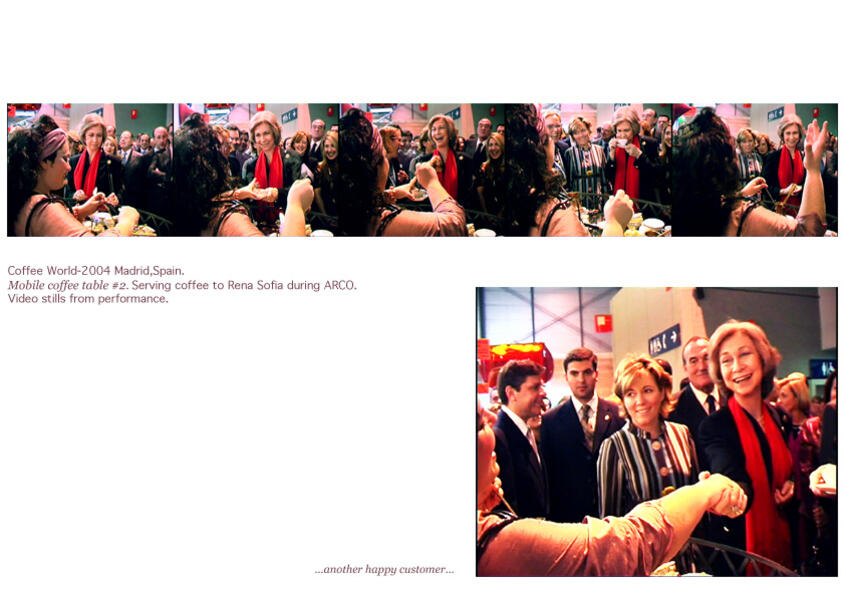 renasofiaThe Mobile Coffee Table. Arco04. Madrid, Spain. Reading the fortune of Rena Sofia, Queen of Spain.
renasofiaThe Mobile Coffee Table. Arco04. Madrid, Spain. Reading the fortune of Rena Sofia, Queen of Spain. -
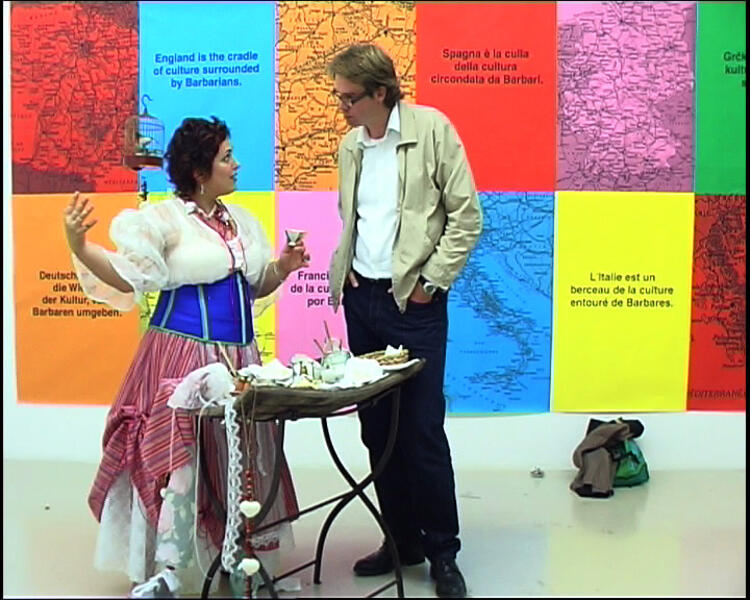 1balz_fullviewprivateThe Mobile Coffee Table. "Balkan Visions". AR/GE Kunst Gallerie Museum. Bolzano, Italy. 2003
1balz_fullviewprivateThe Mobile Coffee Table. "Balkan Visions". AR/GE Kunst Gallerie Museum. Bolzano, Italy. 2003 -
 haritosgettingclose-copyThe Mobile Coffee Table. Haritos Street. Athens, Greece. 2004
haritosgettingclose-copyThe Mobile Coffee Table. Haritos Street. Athens, Greece. 2004 -
 rot full view 1The Mobile Coffee Table. "Motel Mozaique". Rotterdam Schouwburg Theater. Rotterdam, The Netherlands. 2004
rot full view 1The Mobile Coffee Table. "Motel Mozaique". Rotterdam Schouwburg Theater. Rotterdam, The Netherlands. 2004 -
 turningThe Mobile Coffee Table. "Eukabuk, The Chiang Mai Social Installation." Bangkok, Thailand. 2001
turningThe Mobile Coffee Table. "Eukabuk, The Chiang Mai Social Installation." Bangkok, Thailand. 2001 -
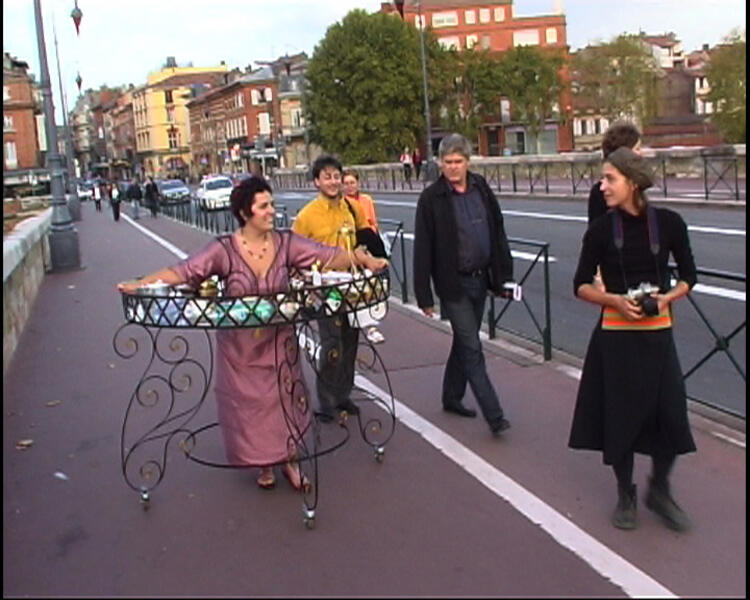 3toul_walkingThe Mobile Coffee Table. "Printemps de setembre. Festival of Contemporary Images." Chateau de Eau. Toulousse, France. 2003
3toul_walkingThe Mobile Coffee Table. "Printemps de setembre. Festival of Contemporary Images." Chateau de Eau. Toulousse, France. 2003 -
 forumpageThe Mobile Coffee Table. "The Forum 2001. Artistic Mobility in a Multicultural Europe." Thessaloniki, Greece
forumpageThe Mobile Coffee Table. "The Forum 2001. Artistic Mobility in a Multicultural Europe." Thessaloniki, Greece -
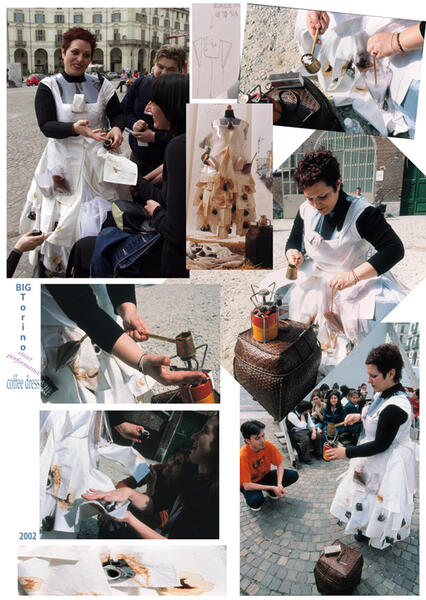 bigtorinodetailsThe Mobile Coffee Table. "Big Torino 2002". In collaboration with FoAM. Torino, Italy
bigtorinodetailsThe Mobile Coffee Table. "Big Torino 2002". In collaboration with FoAM. Torino, Italy
Babylon
Bab·y·lon n
1. a place of great luxury or immorality (disapproving)
2. a place of exile or captivity
Bab·y·lon
The capital of ancient Babylonia, sited on the Euphrates River in modern Iraq. It was known for its opulence, and the Hanging Gardens there were one of the Seven Wonders of the World.
Athanasia Kyriakakos once again surprises us with another fascinating piece deriving from the desires of the human psyche in her loving approach to engaging her audience in dialogue and communication. With her personal challenge to create an intimate exchange between her and her audience and to close the space between performer and participant, she brings us Babylon.
Steel and silk wrap around you. To remind you of drunken desires, hot nights, under stars and grapevines. A stolen kiss. Hot breath. The desire for somebody or something you cannot have. Reminiscence of youth.
The taboo bed growing out of the fantasies of the artist, creates an invisible curtain between the voyeur and the participant. Babylon wraps around the artist and participant in a playful unveiling of desires.
Sia Kyriakakos faces with humor the conditions of a time that is constantly creating desires for consumption of something new and often unobtainable while being restricted by rules and regulations of a society that demands the control of our thoughts and emotions. Taboo thoughts are shared with the audience. Only once the audience lies in the bed, becoming the performer, next to another stranger or even the artist, only then the hidden thoughts which are often drowned behind small talk and politeness, are revealed.
The pillows whisper endlessly of desires unspoken. The obvious sexual desires to political conflicts, overcoming social barriers. . .
Living in this consumption oriented world that thrives through media and advertising, and the constant exposure to manufactured products which are supposed to create a type of lifestyle and the illusion of happiness through their attainment, we forget who we are or what we really want or need. Thus a fake lifestyle is developed built around this logic and an image is constructed for each one of us in order to fit in society. Where are our real desires? What are they? Are they things that we cannot voice? Are we afraid to voice them because that would separate us from the flock?
Sia Kyriakakos invites and challenges you to whisper as loud as you can those desires you have never dared to voice.
1. a place of great luxury or immorality (disapproving)
2. a place of exile or captivity
Bab·y·lon
The capital of ancient Babylonia, sited on the Euphrates River in modern Iraq. It was known for its opulence, and the Hanging Gardens there were one of the Seven Wonders of the World.
Athanasia Kyriakakos once again surprises us with another fascinating piece deriving from the desires of the human psyche in her loving approach to engaging her audience in dialogue and communication. With her personal challenge to create an intimate exchange between her and her audience and to close the space between performer and participant, she brings us Babylon.
Steel and silk wrap around you. To remind you of drunken desires, hot nights, under stars and grapevines. A stolen kiss. Hot breath. The desire for somebody or something you cannot have. Reminiscence of youth.
The taboo bed growing out of the fantasies of the artist, creates an invisible curtain between the voyeur and the participant. Babylon wraps around the artist and participant in a playful unveiling of desires.
Sia Kyriakakos faces with humor the conditions of a time that is constantly creating desires for consumption of something new and often unobtainable while being restricted by rules and regulations of a society that demands the control of our thoughts and emotions. Taboo thoughts are shared with the audience. Only once the audience lies in the bed, becoming the performer, next to another stranger or even the artist, only then the hidden thoughts which are often drowned behind small talk and politeness, are revealed.
The pillows whisper endlessly of desires unspoken. The obvious sexual desires to political conflicts, overcoming social barriers. . .
Living in this consumption oriented world that thrives through media and advertising, and the constant exposure to manufactured products which are supposed to create a type of lifestyle and the illusion of happiness through their attainment, we forget who we are or what we really want or need. Thus a fake lifestyle is developed built around this logic and an image is constructed for each one of us in order to fit in society. Where are our real desires? What are they? Are they things that we cannot voice? Are we afraid to voice them because that would separate us from the flock?
Sia Kyriakakos invites and challenges you to whisper as loud as you can those desires you have never dared to voice.
Aloni
Aloni
Two circles. One over us. One under us. The sounds of whispers around us.
The smell of earth. The scent of spring and its death. Hovering between consciousness and unconsciousness.
A carpet of faces. A sky of flowers.The dream. A whisper in the night.
Part of our unconsciousness. Part of our most intimate moments, where physical and metaphysical come
together and meet in something invisible, like a breath.
When I was six I came to this space. The animals tied together, side by side. The people walking behind them. The sound of the grinding of the hay under the hooves, against the rock. The whisper of the wind between the barley flakes falling. The gold in the air sifting through the pitchforks. I remember it like a dream, but it was real. It shaped my vision of life. A village working together lead by the animals used to do their labor. Harvesting, sorting, a slow movement that happened between nature and man like a dance. And the wind, also doing its part. Carrying their voices, carrying the hay away from the barley. Creating gold, misting the blue sky.
White stone, red earth. Clear white light. Faces carved with time and the labor of living.
In circles.
The project proposed for the Contemporary Art Center of Thessaloniki consisted of four elements. The floor, the ceiling, the sound, the performance. The earth, the sky, the wind. And the dream that ties it all together. The dream of a child.
On the floor were hundreds of wet clay faces, forming a growing circle of four square meters. The faces were of women I have been in contact with in my life. Of people I have shared dreams with. The most important ones in the center, the core, gently covered in gold leaf, impermanently stuck on, flaking away with time. And between the faces made out of the red clay - white flour. The circle of faces grew, during the exhibition as the audience became part of the circle, part of its melody.
Hanging over the aloni of faces was a mesh made out of metal, forming almost an umbrella off of which flowers strung up together hung in a circle of four square meters. The flowers red roses to eventually dry into almost black with a scent that faded but would was extremely potent at the beginning. As the circle of faces would grow on the ground, so would the circle of flowers off the ceiling.
Around the space, through the two circles the wind carried the sound of whispers, whispers of peopleâ??s dreams. Recorded digitally, played off CDs, constantly being added on to. They began with dreams that had been collected for over two years.
The performance required the active participation of the audience, both physical and virtual. The audience was invited to share a dream they had experienced at night. An extension of the project is in process now with the creation of a website. Soon the audience can leave a dream on sight through text. The text dreams would be handwritten by the artist and displayed on the wall around the space with a later display of the piece.
During the physical interviews, the artist shaped the face of the participant out of clay.
With each new day, new clay faces, new dreams, and a fresh row
of flowers were added to the circle.
In this manner, the circle was reborn with the wake of every morning.
Two circles. One over us. One under us. The sounds of whispers around us.
The smell of earth. The scent of spring and its death. Hovering between consciousness and unconsciousness.
A carpet of faces. A sky of flowers.The dream. A whisper in the night.
Part of our unconsciousness. Part of our most intimate moments, where physical and metaphysical come
together and meet in something invisible, like a breath.
When I was six I came to this space. The animals tied together, side by side. The people walking behind them. The sound of the grinding of the hay under the hooves, against the rock. The whisper of the wind between the barley flakes falling. The gold in the air sifting through the pitchforks. I remember it like a dream, but it was real. It shaped my vision of life. A village working together lead by the animals used to do their labor. Harvesting, sorting, a slow movement that happened between nature and man like a dance. And the wind, also doing its part. Carrying their voices, carrying the hay away from the barley. Creating gold, misting the blue sky.
White stone, red earth. Clear white light. Faces carved with time and the labor of living.
In circles.
The project proposed for the Contemporary Art Center of Thessaloniki consisted of four elements. The floor, the ceiling, the sound, the performance. The earth, the sky, the wind. And the dream that ties it all together. The dream of a child.
On the floor were hundreds of wet clay faces, forming a growing circle of four square meters. The faces were of women I have been in contact with in my life. Of people I have shared dreams with. The most important ones in the center, the core, gently covered in gold leaf, impermanently stuck on, flaking away with time. And between the faces made out of the red clay - white flour. The circle of faces grew, during the exhibition as the audience became part of the circle, part of its melody.
Hanging over the aloni of faces was a mesh made out of metal, forming almost an umbrella off of which flowers strung up together hung in a circle of four square meters. The flowers red roses to eventually dry into almost black with a scent that faded but would was extremely potent at the beginning. As the circle of faces would grow on the ground, so would the circle of flowers off the ceiling.
Around the space, through the two circles the wind carried the sound of whispers, whispers of peopleâ??s dreams. Recorded digitally, played off CDs, constantly being added on to. They began with dreams that had been collected for over two years.
The performance required the active participation of the audience, both physical and virtual. The audience was invited to share a dream they had experienced at night. An extension of the project is in process now with the creation of a website. Soon the audience can leave a dream on sight through text. The text dreams would be handwritten by the artist and displayed on the wall around the space with a later display of the piece.
During the physical interviews, the artist shaped the face of the participant out of clay.
With each new day, new clay faces, new dreams, and a fresh row
of flowers were added to the circle.
In this manner, the circle was reborn with the wake of every morning.
Efrosini
Sometimes desire skips a generation. What parents need to flee becomes the catalyst for the imagination of their children--those who did not live the hardship and see only the beauty. There is nostalgia for what has remained perfect because it has lived only in memory. In memory such space does not age because it was old from the beginning. It is all texture, smell, light lodged in the imaginary body of the child that lives with immutability in the adult.
Such is the discourse of the house spun from the memory of Athanasia Kyriakakos. She chose silk organza to let in the light, to keep it light as the dream from which it has emerged. Made to the scale of her grandmotherâ??s house, which is alive always in her mindâ??s eye, she relied on sewing--her motherâ??s profession. And she engaged a community of artists to work with her to be sure that the ritual of the making became as important as the finished object itself: Pots, pans, glasses, a pail, a stove all made of silk. This is the stuff of dreamsâ??prescribed by the forms of the physical yet at any moment capable of being morphed into their opposite or merely blown away. There is the specificity of place, of Athanasiaâ??s remembrance of place, and yet the house becomes all places that shaped our imaginations and from which we have been exiled by time.
The genius of the design is in the incongruity of the materials--the unexpected realization of a house made from the stuff of a dress, the dress of the artist made from the stuff of the house, and the house a referent to the most intangible of allâ??that time of life, childhood, that state of consciousness, memory, which are ever present but nonetheless lost to us forever.
Carol Becker, Dean, The School of the Art Institute of Chicago
From the exhibition catalogue of the Deste Prize 2001. The Deste Foundation, Athens Greece.
Such is the discourse of the house spun from the memory of Athanasia Kyriakakos. She chose silk organza to let in the light, to keep it light as the dream from which it has emerged. Made to the scale of her grandmotherâ??s house, which is alive always in her mindâ??s eye, she relied on sewing--her motherâ??s profession. And she engaged a community of artists to work with her to be sure that the ritual of the making became as important as the finished object itself: Pots, pans, glasses, a pail, a stove all made of silk. This is the stuff of dreamsâ??prescribed by the forms of the physical yet at any moment capable of being morphed into their opposite or merely blown away. There is the specificity of place, of Athanasiaâ??s remembrance of place, and yet the house becomes all places that shaped our imaginations and from which we have been exiled by time.
The genius of the design is in the incongruity of the materials--the unexpected realization of a house made from the stuff of a dress, the dress of the artist made from the stuff of the house, and the house a referent to the most intangible of allâ??that time of life, childhood, that state of consciousness, memory, which are ever present but nonetheless lost to us forever.
Carol Becker, Dean, The School of the Art Institute of Chicago
From the exhibition catalogue of the Deste Prize 2001. The Deste Foundation, Athens Greece.
-
 13full_view_with_peopleErosini. silk organza, beads, wood 20' x 13' x 14' and growing work in progress Performative installation. Work in progress for life. Designed to travel in a suitcase. Efrosini is a replica of Athanasia Kyriakakosâ?? grandmotherâ??s house from the village of Filia in Greece. It is built from silk organza, hand sewn by the artist, to scale but from memory, as it related to the artistâ??s body when she was a child. The house was first sewn and exhibited in Chicago and in many ways it was the beginning of the journey for the artist to return to Greece. It was then shown in Athens and in Cintenje. It was set up first as the shell of the house. Slowly with time, with each exhibition it fills up with furniture, dishes, and all that once was. The artist sits within the space at the time of the exhibition wearing a dress built out of the same material and constructed in the same way as the roof. While there she invites her audience to sew on her as she sews objects for the house. The audience becomes the family, the neighbors, the people who once walked into the real house. The work shared is often quiet, but sometimes it is joined by conversation of another house, of another place, of another person who has passed through our lives. With each presentation of Efrosini, just as with a real house, the life brought in by the audience and the artist makes it richer with objects and embodies the memory that it represents.
13full_view_with_peopleErosini. silk organza, beads, wood 20' x 13' x 14' and growing work in progress Performative installation. Work in progress for life. Designed to travel in a suitcase. Efrosini is a replica of Athanasia Kyriakakosâ?? grandmotherâ??s house from the village of Filia in Greece. It is built from silk organza, hand sewn by the artist, to scale but from memory, as it related to the artistâ??s body when she was a child. The house was first sewn and exhibited in Chicago and in many ways it was the beginning of the journey for the artist to return to Greece. It was then shown in Athens and in Cintenje. It was set up first as the shell of the house. Slowly with time, with each exhibition it fills up with furniture, dishes, and all that once was. The artist sits within the space at the time of the exhibition wearing a dress built out of the same material and constructed in the same way as the roof. While there she invites her audience to sew on her as she sews objects for the house. The audience becomes the family, the neighbors, the people who once walked into the real house. The work shared is often quiet, but sometimes it is joined by conversation of another house, of another place, of another person who has passed through our lives. With each presentation of Efrosini, just as with a real house, the life brought in by the audience and the artist makes it richer with objects and embodies the memory that it represents. -
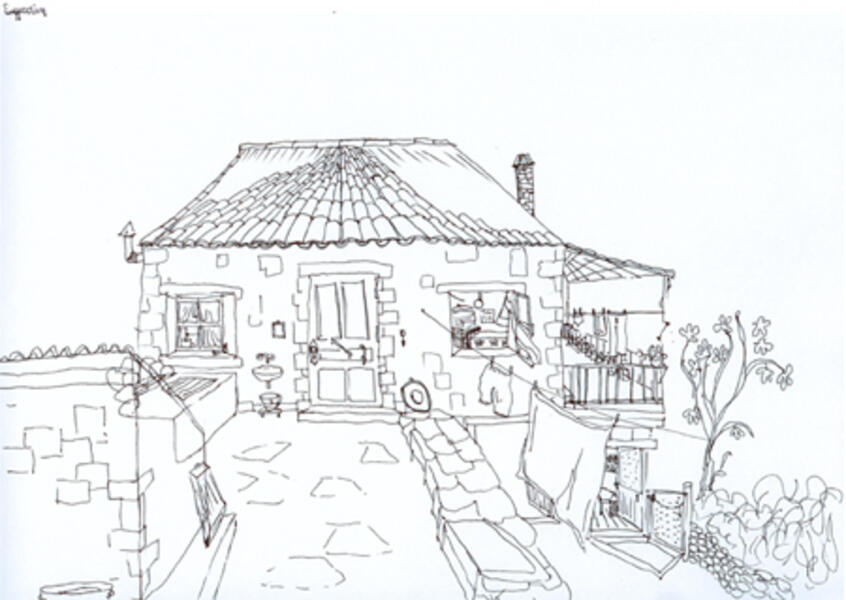 03drawingefrosiniDrawing of artist's grandmother's home as she remembered it from her first visit at the age of six. The Grandmother's name was Efrosini.
03drawingefrosiniDrawing of artist's grandmother's home as she remembered it from her first visit at the age of six. The Grandmother's name was Efrosini. -
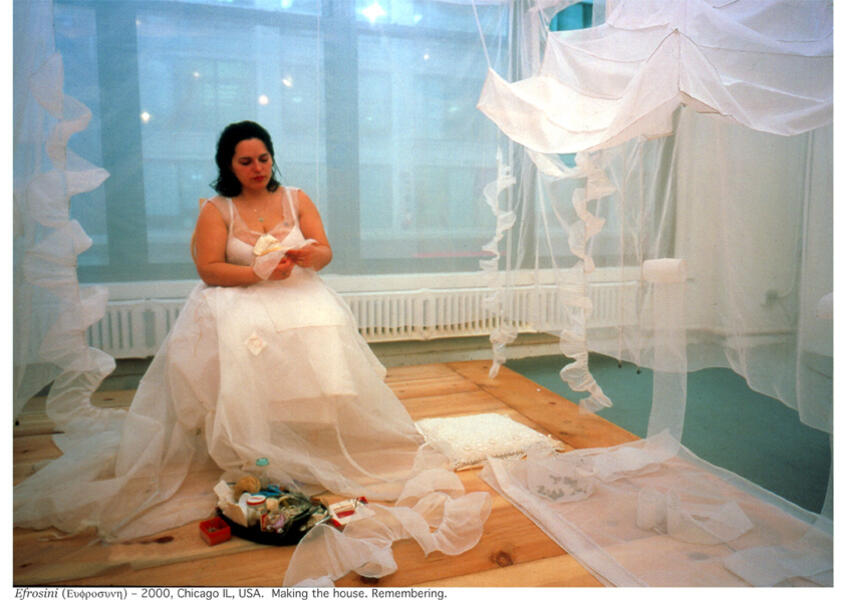 07sittingaloneErosini. The artist sewing objects for the house in a silk dress which copied the structure of the roof to create the skirt. She is waiting for the audience to come and silently join her in the sewing. To sew on her as she sews the house.
07sittingaloneErosini. The artist sewing objects for the house in a silk dress which copied the structure of the roof to create the skirt. She is waiting for the audience to come and silently join her in the sewing. To sew on her as she sews the house. -
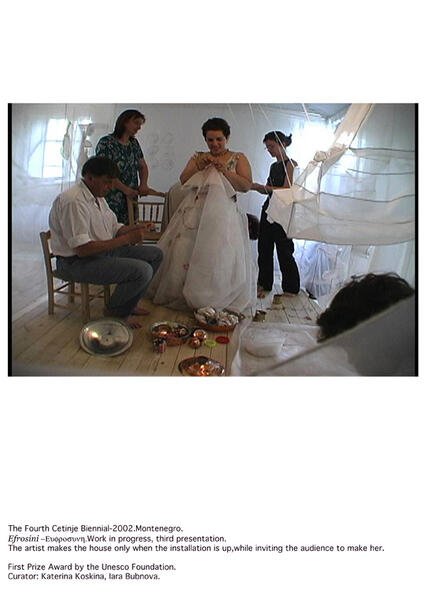 10efrosinsiwpetrovichEfrosini. Participants sewing on the artist's dress. From the installation at the Citenje Biennale.
10efrosinsiwpetrovichEfrosini. Participants sewing on the artist's dress. From the installation at the Citenje Biennale. -
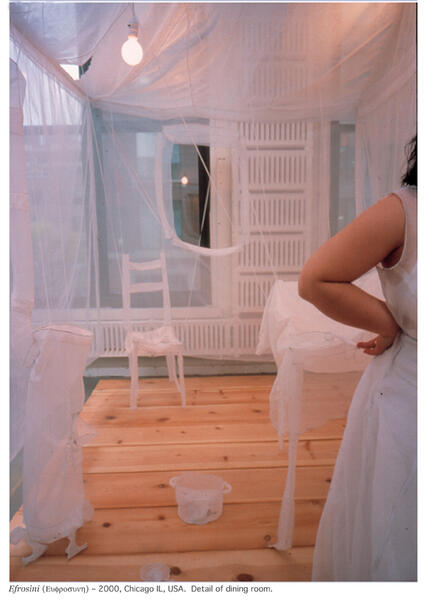 06diningroomwithartistEfrosini. Detail of living room objects with the artist.
06diningroomwithartistEfrosini. Detail of living room objects with the artist. -
 09kitchenEfrosini. Detail of kitchen, with the artist.
09kitchenEfrosini. Detail of kitchen, with the artist. -
 08faucetEfrosini. Detail of kitchen water container/faucet. silk organza.
08faucetEfrosini. Detail of kitchen water container/faucet. silk organza. -
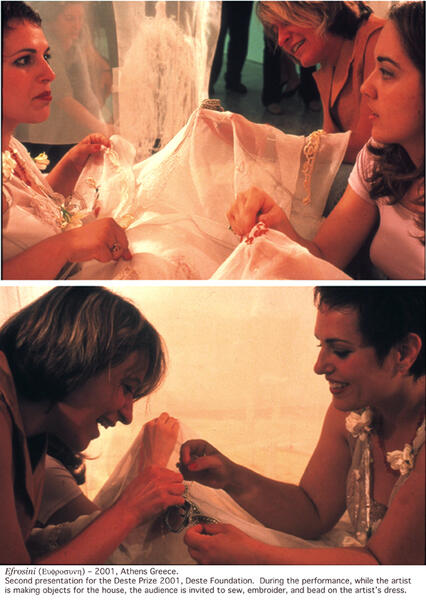 12efrosini_with_katerinaInteracting with participants of Efrosini
12efrosini_with_katerinaInteracting with participants of Efrosini -
 01_efrosini_detailpageDetails of dress and performance from Efrosini
01_efrosini_detailpageDetails of dress and performance from Efrosini -
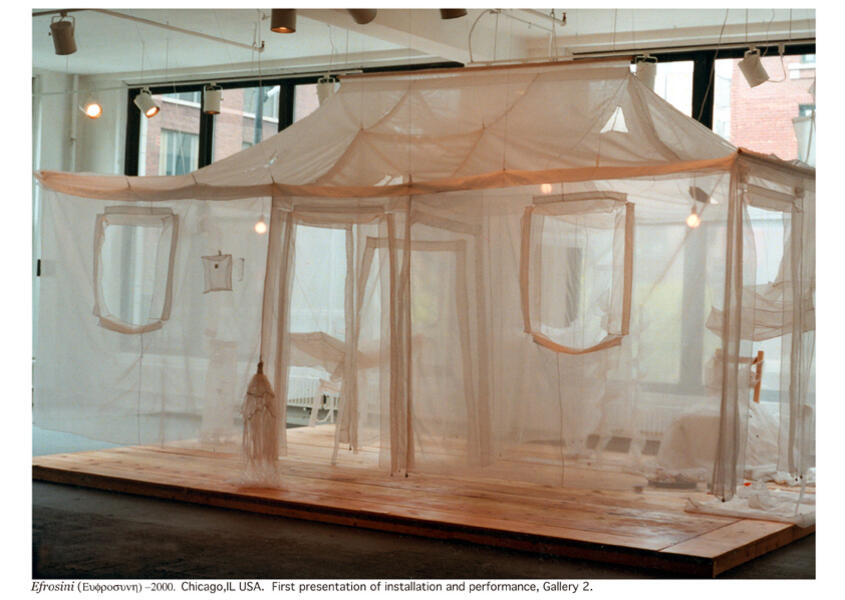 04full_view_emptyEfrosini. Full view.
04full_view_emptyEfrosini. Full view.
Between Two Destinations
â??Between Two Destinationsâ?, Performative Installation
Fabric, video, barley, television sets, shoes, CD player, pomegranates
"10 Rooms 2000", Kappatos Gallery in the St. George Lycabettus Hotel, Athens, Greece.
Curator: Efi Strousa
Between Two Destinations was an interdisciplinary performative installation created site specifically in a hotel room under the guidance of the Kappatos Gallery in Athens, Greece. The hotel space was acknowledged as an integral part of the final art piece. For me, the hotel room became the space in time between two places - an origin and a destination. It was the present between the past and the future. It was the moment that we exist in. It was this same moment that I wanted to capture in my life, and in a metaphorical symbolic way, recreate it as an aesthetic experience. I am a Greek - American - Greek. I was born in America, raised in Greece, and returned to America to be educated. I am trapped between cultures, an old one undergoing a rapid change, which is influenced by the newer culture.
So I thought it would be appropriate for me in this hotel space, a space of transition, to create the landscapes that I exist within. One landscape being that of my ancestors, visceral, made out of real things - materials that you can touch, feel, smell, taste, and hear. The other, the American, belonging to my future. In this I used the tools of mass communication which constantly bombard us on a daily basis â?? television, video, computers, moving images â??composing a virtual experience for the senses. Marrying the two landscapes, would be I, the bride stained by culture.
The Greek â??landscapeâ? was conceived initially as a memorial to my Grandfather, who recently passed away. As I wasnâ??t able to participate in the ritualistic ceremonies that take place in Greece when burying the dead, I felt compelled to create a work that involved ritual. So I created a wall that had foundation composed of hundreds of pairs of shoes (my Grandfather was a shoemaker). The shoes were stacked the same way you would stack wood next to your fireplace, evoking the idea of time gone by and the people that might have worn them. Over the shoes were laid all of my blankets, the things that kept me warm within my home (my γοÏ?κο). The blankets were meticulously folded and wrapped in white sheets, so the blanket itself could not be seen. They stacked high above the shoes, and created the illusion of a section of earth that has been sliced to reveal the different layers. This made the shoes look like they were very deep under the earth. As deep as the generations of my family go back in history. Between the folds of the sheets lay bleeding; cut open pomegranates, one for each one of my Grandfatherâ??s children. As time went by, they rotted and dried - always talking about time and presence. An audio component integral to the piece, whispered for an ongoing thirty-one minutes, (my age) . . . να ζηÏ?ειs να Ï?ον θÏ?μαÏ?αι (may you live to remember him).
I am very interested in how memory is triggered and retained. How do we pass down our history? How do we remember? I believe that it is the people in our lives that define us as individuals. They hold our history. As my memory will hold the history of my Grandfather and consequently of my people.
The other â??landscapeâ? was the one I exist in now. I live in a city in America. The potential is unlimited. The opportunities open. The choices too many. Yet America has another side. It is the landscape that you find traveling between cities. The endless road between cornfields. It is the side that we donâ??t necessarily recognize with the fast life of the west. I was interested in capturing this on video, within a car, the same way I have experienced it for the past sixteen years. The road trip, part of the American myth. Directly across from the Greek â??landscapeâ? was the American â??landscapeâ?. Quiet, passing by you, on three screens: the right view, the front, and the left, all from an automobile. This â??landscapeâ?, this experience, was virtual. The images were videotaped, streaming before you, making you feel like you were traveling through a space, streaming before you in the same way they stream through advertising into other cultures, creating desire. This â??landscapeâ? was digital, like the world it came from. The road itself is called US 31. It is the same road that led to the town where my American husband was raised. Again my age is encompassed within the roadâ??s name. The length of the video is 52 minutes, the age of my Mother. And the shoes in the bottom of the Greek landscape are my motherâ??s and my own. I tied the two landscapes together. During the duration of the exhibition I remained in the room wearing a white dress, a cross between a wedding dress and a nightgown. I would cut pomegranates and offer them to the audience while inviting them to talk about culture.
Within the hotel room I wanted to create a space which reflected my present, tying the ritual with the virtual. While I wanted to continue an oral tradition that was passed down to me through generations, I used new technologies to discover again this oral tradition and reestablish it as part of my present time. I sought to extend memory and experience.
Fabric, video, barley, television sets, shoes, CD player, pomegranates
"10 Rooms 2000", Kappatos Gallery in the St. George Lycabettus Hotel, Athens, Greece.
Curator: Efi Strousa
Between Two Destinations was an interdisciplinary performative installation created site specifically in a hotel room under the guidance of the Kappatos Gallery in Athens, Greece. The hotel space was acknowledged as an integral part of the final art piece. For me, the hotel room became the space in time between two places - an origin and a destination. It was the present between the past and the future. It was the moment that we exist in. It was this same moment that I wanted to capture in my life, and in a metaphorical symbolic way, recreate it as an aesthetic experience. I am a Greek - American - Greek. I was born in America, raised in Greece, and returned to America to be educated. I am trapped between cultures, an old one undergoing a rapid change, which is influenced by the newer culture.
So I thought it would be appropriate for me in this hotel space, a space of transition, to create the landscapes that I exist within. One landscape being that of my ancestors, visceral, made out of real things - materials that you can touch, feel, smell, taste, and hear. The other, the American, belonging to my future. In this I used the tools of mass communication which constantly bombard us on a daily basis â?? television, video, computers, moving images â??composing a virtual experience for the senses. Marrying the two landscapes, would be I, the bride stained by culture.
The Greek â??landscapeâ? was conceived initially as a memorial to my Grandfather, who recently passed away. As I wasnâ??t able to participate in the ritualistic ceremonies that take place in Greece when burying the dead, I felt compelled to create a work that involved ritual. So I created a wall that had foundation composed of hundreds of pairs of shoes (my Grandfather was a shoemaker). The shoes were stacked the same way you would stack wood next to your fireplace, evoking the idea of time gone by and the people that might have worn them. Over the shoes were laid all of my blankets, the things that kept me warm within my home (my γοÏ?κο). The blankets were meticulously folded and wrapped in white sheets, so the blanket itself could not be seen. They stacked high above the shoes, and created the illusion of a section of earth that has been sliced to reveal the different layers. This made the shoes look like they were very deep under the earth. As deep as the generations of my family go back in history. Between the folds of the sheets lay bleeding; cut open pomegranates, one for each one of my Grandfatherâ??s children. As time went by, they rotted and dried - always talking about time and presence. An audio component integral to the piece, whispered for an ongoing thirty-one minutes, (my age) . . . να ζηÏ?ειs να Ï?ον θÏ?μαÏ?αι (may you live to remember him).
I am very interested in how memory is triggered and retained. How do we pass down our history? How do we remember? I believe that it is the people in our lives that define us as individuals. They hold our history. As my memory will hold the history of my Grandfather and consequently of my people.
The other â??landscapeâ? was the one I exist in now. I live in a city in America. The potential is unlimited. The opportunities open. The choices too many. Yet America has another side. It is the landscape that you find traveling between cities. The endless road between cornfields. It is the side that we donâ??t necessarily recognize with the fast life of the west. I was interested in capturing this on video, within a car, the same way I have experienced it for the past sixteen years. The road trip, part of the American myth. Directly across from the Greek â??landscapeâ? was the American â??landscapeâ?. Quiet, passing by you, on three screens: the right view, the front, and the left, all from an automobile. This â??landscapeâ?, this experience, was virtual. The images were videotaped, streaming before you, making you feel like you were traveling through a space, streaming before you in the same way they stream through advertising into other cultures, creating desire. This â??landscapeâ? was digital, like the world it came from. The road itself is called US 31. It is the same road that led to the town where my American husband was raised. Again my age is encompassed within the roadâ??s name. The length of the video is 52 minutes, the age of my Mother. And the shoes in the bottom of the Greek landscape are my motherâ??s and my own. I tied the two landscapes together. During the duration of the exhibition I remained in the room wearing a white dress, a cross between a wedding dress and a nightgown. I would cut pomegranates and offer them to the audience while inviting them to talk about culture.
Within the hotel room I wanted to create a space which reflected my present, tying the ritual with the virtual. While I wanted to continue an oral tradition that was passed down to me through generations, I used new technologies to discover again this oral tradition and reestablish it as part of my present time. I sought to extend memory and experience.
"New Greeks?"
â??New Greeks?â?
Returning to Greece after being in the United States for 16 years, what struck me was the homogeneity of the people. Within the three years I have been here my perception has changed and the colors of the people in and out of Athens have become richer as the flow of immigrants has increased.
This is a phenomenon not unique to Athens or Greece. It is worldwide. All of Europe is flooded with people from poorer countries, displaced, seeking a new life and future for their children. Many supporting families they have left behind. Often they have sold everything in order to get to the dreamland. Their journeys, treacherous, perhaps symbolizing the battle that lies before them. Some succeed, most struggle as they fight through the social walls, prejudices, and the daily realities of being foreign amongst foreigners in a strange land.
These are the people we donâ??t see. That we ignore. Perhaps when I came to Greece three years ago, they were here already, but I did not notice them. They were as invisible to me as they were to the rest of the dominant society. It became obvious to me that I had not been hearing well enough or seeing close enough. The streets of Athens are obviously flooded with non-Greeks, with New-Greeks.
â??New Greeks?â? addresses issues of immigration, mobility, social structure, and communication, focusing on the people who are â??buildingâ? Greece today. As they try to restructure their lives, they are constructing a new culture within the borders of Greece. The exhibition is comprised of three components. Dominating the space, a wooden wall, divides the gallery violently in two. It is the physical wall built for the cement to be poured for the foundation of any structure in Greece. Around it, against the walls and hanging from the ceilings, a series of photographs depicts immigrants at the time of work, their relationship to each other and their environments. In the third component, a video is projected against a cast resin wall depicting todayâ??s workforce waiting to be chosen in the early morning.
The â??kalloupiaâ? wall is made out of the tattered wood re-used from construction site to construction site. It is the first step to building anything in Greek architecture. Onto the cement, cast out of this wood is always printed the physical texture of the wood itself, almost â??writingâ? the history that is carried on the wood. A symbolic language printed under the structure of every building, carrying with it the foundation and the reconstruction of society itself. The kalloupi is the invisible behind the building.
Who is todayâ??s kalloupi? What is our society being imprinted with? Who is helping it happen?
The series of photographs depict our immigrants, the New Greeks at work. Each one a pair of photographs, one with and one without their environment. This is to force the audience to take a look at what our glance tends to objectify. Treated with honor, their images are embellished with silver and beads. The silver is worked in traditional methods of hammering â??tamataâ? and strategically replaces the parts of bodies and tools that these people use in order to make their living, and in combination with the glass, the images are transformed and take a dimension beyond the ordinary. The individuals become heroes of todayâ??s society. They are the modern warriors and despite their circumstances, they are proud.
The third component of the video projected on the poured resin wall whoâ??s kalloupi has not been removed, shows individuals of different ethnicities waiting in the early morning in different parts of Athens for somebody to pick them up to work. The resin wall shows its structure and carries its own transparency. It is made out of industrial materials that are as toxic as our prejudice and the symbolic walls that we build in our society. The wood of the kalloupi is left as evidence of the history that we are building together.
Returning to Greece after being in the United States for 16 years, what struck me was the homogeneity of the people. Within the three years I have been here my perception has changed and the colors of the people in and out of Athens have become richer as the flow of immigrants has increased.
This is a phenomenon not unique to Athens or Greece. It is worldwide. All of Europe is flooded with people from poorer countries, displaced, seeking a new life and future for their children. Many supporting families they have left behind. Often they have sold everything in order to get to the dreamland. Their journeys, treacherous, perhaps symbolizing the battle that lies before them. Some succeed, most struggle as they fight through the social walls, prejudices, and the daily realities of being foreign amongst foreigners in a strange land.
These are the people we donâ??t see. That we ignore. Perhaps when I came to Greece three years ago, they were here already, but I did not notice them. They were as invisible to me as they were to the rest of the dominant society. It became obvious to me that I had not been hearing well enough or seeing close enough. The streets of Athens are obviously flooded with non-Greeks, with New-Greeks.
â??New Greeks?â? addresses issues of immigration, mobility, social structure, and communication, focusing on the people who are â??buildingâ? Greece today. As they try to restructure their lives, they are constructing a new culture within the borders of Greece. The exhibition is comprised of three components. Dominating the space, a wooden wall, divides the gallery violently in two. It is the physical wall built for the cement to be poured for the foundation of any structure in Greece. Around it, against the walls and hanging from the ceilings, a series of photographs depicts immigrants at the time of work, their relationship to each other and their environments. In the third component, a video is projected against a cast resin wall depicting todayâ??s workforce waiting to be chosen in the early morning.
The â??kalloupiaâ? wall is made out of the tattered wood re-used from construction site to construction site. It is the first step to building anything in Greek architecture. Onto the cement, cast out of this wood is always printed the physical texture of the wood itself, almost â??writingâ? the history that is carried on the wood. A symbolic language printed under the structure of every building, carrying with it the foundation and the reconstruction of society itself. The kalloupi is the invisible behind the building.
Who is todayâ??s kalloupi? What is our society being imprinted with? Who is helping it happen?
The series of photographs depict our immigrants, the New Greeks at work. Each one a pair of photographs, one with and one without their environment. This is to force the audience to take a look at what our glance tends to objectify. Treated with honor, their images are embellished with silver and beads. The silver is worked in traditional methods of hammering â??tamataâ? and strategically replaces the parts of bodies and tools that these people use in order to make their living, and in combination with the glass, the images are transformed and take a dimension beyond the ordinary. The individuals become heroes of todayâ??s society. They are the modern warriors and despite their circumstances, they are proud.
The third component of the video projected on the poured resin wall whoâ??s kalloupi has not been removed, shows individuals of different ethnicities waiting in the early morning in different parts of Athens for somebody to pick them up to work. The resin wall shows its structure and carries its own transparency. It is made out of industrial materials that are as toxic as our prejudice and the symbolic walls that we build in our society. The wood of the kalloupi is left as evidence of the history that we are building together.



